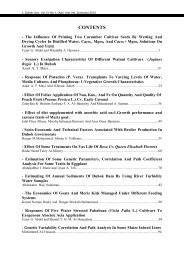Create successful ePaper yourself
Turn your PDF publications into a flip-book with our unique Google optimized e-Paper software.
J. Duhok Univ., Vol. 14, No.1 (Pure and Eng. Sciences), Pp 1-8, 2011<br />
“metaproject” amongst the proposed strategic<br />
projects.<br />
The construction and the use of a polyvalent<br />
evaluation model go towards the direction to<br />
conceive the strategic planning process as an<br />
intelligent guide of sectorial and precise actions<br />
being already operational, be them policies or<br />
works: evidencing and exploiting the positive<br />
energies existing in the territory. In any case it is<br />
thus necessary a cognitive apparatus (a record of<br />
the projects and of the actions being carried out<br />
in the project’s area, be it institutional or not)<br />
which could allow the evaluation and, case by<br />
case, exploitation, correction, integration<br />
(Piroddi E., 1999).<br />
The target is that of selecting projects and<br />
policies which might contribute to the increase<br />
of the territorial and environmental quality. If<br />
the development sustainability depends from the<br />
equilibrium and the synergies between<br />
economical, territorial, environmental and social<br />
transformations, to increase the territorial<br />
patrimony, it is just on the inter-sectorial<br />
relations that the single actions’ coherence must<br />
be searched. The construction of a polyvalent<br />
evaluation model of policies, plans and projects<br />
referred to each strategic project area constitutes<br />
a prominent element of the proposed planning<br />
methodology. In this picture the evaluation<br />
which means to attribute to a project or to a plan<br />
quality or criticity characteritsics becomes<br />
intrisecally tied to the decision and projectual<br />
action, making explicit and verifiable the<br />
projectual choices towards the local territorial<br />
impact optimization criteria.<br />
THE PROSPECT OF THE PLAN IN<br />
LOCAL DEVELOPMENT<br />
It is typically a planning activity of integrated<br />
type, in the sense that it points to exploit the<br />
effects that derive from putting in a net different<br />
sector's policies and interventions demand<br />
crucial (Mazza L., 1977). It is a creative process,<br />
in which each involved subject, bearer of a<br />
specific definition of the problems, of the<br />
priority and the development necessity,<br />
contributes to elaborate the basic orientation and<br />
the missions of the community. In this sense it<br />
intends to activate – and this constitutes perhaps<br />
its most important result – an actors’ selfreflection<br />
process (Forester J. 1989, Porter<br />
M.1987) about the future of a territory.<br />
The plan has therefore, as aim, the<br />
construction of a document which can<br />
individuate the problems, the opportunities, a<br />
territory’s development targets 7 and scenarios.<br />
Certainly the plan takes the territory as its’<br />
application field (Mazza L., 1997), but it looks<br />
towards the town as the possible policies’ space<br />
and therefore from time to time its reference<br />
changes. It can be a specific dimension because<br />
it is recognized by the local actors as worth of<br />
particular attention (requalification of the<br />
historical town) or in a wider sphere, referred to<br />
the different development geographies (the role<br />
of the town in a territorial context).<br />
The plan reference territory therefore is not a<br />
data but a sequence (construction), it depends<br />
from the places toward which the actors’<br />
attention is drawn and from the level at which<br />
the questions that they put can be treated.<br />
In order to respond to the challenges that the<br />
future delineates it is necessary to take into<br />
consideration some principles.<br />
1.The first principle refers to the assumption of a<br />
pragmatic approach, which doesn’t wait the<br />
completion of a comprehesive project to be able<br />
to operate, but which starts to work in the sense<br />
of the anticipation of that general project.<br />
Between comprehensive project and details<br />
choices it is necessary to establish a co-evolution<br />
connection, in the sense that the second<br />
contribute to define the first but that from this<br />
they are also conditioned.<br />
Let’s take the case of the historical town. It<br />
deals with a town’s area that seems to require the<br />
activation of a regeneration complex policy (that<br />
is to say made of different interventions and<br />
integrated between them) which can’t wait the<br />
conclusion of the general variant’s iter<br />
to be started, but that, instead, can supply to<br />
the General Town Plan interesting test elements<br />
and, more in general, useful indications to the<br />
urban policies on how to plan multidimensional<br />
interventions. The strategic plan intends to<br />
consider the pragmatic approach as its own<br />
orientation principle, indicating those actions<br />
which can be immediately started or that it is<br />
necessary to discuss for their relevance.<br />
2. The second principle is that of subsidiarity, as<br />
the modality to define the relations between the<br />
institutional subjects and, more in general,<br />
between the public policies’ actors. The<br />
subsidiarity concerns the appointment of<br />
competences towards those subjects who are the<br />
nearest to the treatment of the problems (be<br />
these public or private) and therefore an<br />
assumption of responsibility by them.<br />
5



